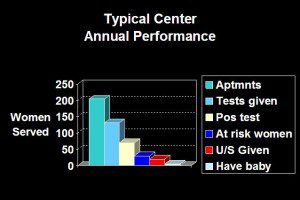Imagine 95% of the pregnant clients that walk through your doors at risk for abortion. What if I told you that there are pregnancy centers currently operating for whom this is happening. What if I told you that there are medical PRCs right now for whom 80-90% of their client load is actually pregnant?
There is a saying I use in our executive training OT training, “Strategic Marketing is everything you do.” It is important to note that it really does not matter how large of a population you are attempting to reach, the population of women is fairly connected and the group of women you need to reach is always a very small percentage of that larger population of women and perhaps even more connected to one another due to their close age (18-24). Essentially this means that word gets out fast about an organization in terms of what is provided and how it is provided even in fairly large towns.
The average pregnancy resource center spends less than 10% of its resources on pregna nt women who are seriously considering abortion. The following graph represents typical trends seen in the average PRC. Note that with each step there is approximately a 50% reduction in the number of women who actually qualify to go to the next level of service. Whether your organization is scheduling 1000 appointments or 100 take a look at your trends and see if they are in the ball park with the trends shown in this graph.
nt women who are seriously considering abortion. The following graph represents typical trends seen in the average PRC. Note that with each step there is approximately a 50% reduction in the number of women who actually qualify to go to the next level of service. Whether your organization is scheduling 1000 appointments or 100 take a look at your trends and see if they are in the ball park with the trends shown in this graph.
Advertising outlets and messaging is only as effective at reaching the abortion-minded woman as your service delivery strategy is at over delivering on her expectations. In fact advertising that hits your target of at risk women will work against you over time on a bell curve if the services provided do not match with her expectations. If an organization has a reputation for not providing relevant services or providing those services in a relevant way, even if that reputation is outdated or untrue, it will take at least a four year cycle to reinvent that reputation through re-engineering the services that are provided and the manner in which they are provided to better match with the expectations of the woman who is considering abortion.
What every PRC executive wants is to move their organization from the trend shown in the graph above to the one shown below. But we cannot get there by doing more of what we are currently doing. To save 1000 lives with the current service process used in an average medical PRC they would have to schedule over 25000 appointments every year. I don’t know of a single organization that has the resources to do that. We have to be willing to understand what is not working and change it to see more lives saved using fewer resources.
Imagine seeing more at risk pregnant women and more of them having their babies while having your overall non-pregnant or not-at-risk client load decrease to less than 5% of the total clients your serve. The best way to optimize the results your center is getting is by re-engineering your services, moving from a traditional or client-focused model to a linear or problem-focused model of service. You can read more about it at www.compasscaretraining.org.
 nt women who are seriously considering abortion. The following graph represents typical trends seen in the average PRC. Note that with each step there is approximately a 50% reduction in the number of women who actually qualify to go to the next level of service. Whether your organization is scheduling 1000 appointments or 100 take a look at your trends and see if they are in the ball park with the trends shown in this graph.
nt women who are seriously considering abortion. The following graph represents typical trends seen in the average PRC. Note that with each step there is approximately a 50% reduction in the number of women who actually qualify to go to the next level of service. Whether your organization is scheduling 1000 appointments or 100 take a look at your trends and see if they are in the ball park with the trends shown in this graph.

